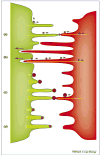Cytonemes and tunneling nanotubules in cell-cell communication and viral pathogenesis
- PMID: 18703335
- PMCID: PMC2628975
- DOI: 10.1016/j.tcb.2008.07.003
Cytonemes and tunneling nanotubules in cell-cell communication and viral pathogenesis
Abstract
Cells use a variety of intercellular structures, including gap junctions and synapses, for cell-cell communication. Here, we present recent advances in the understanding of thin membrane bridges that function in cell-cell signaling and intercellular transport. Cytonemes or filopodial bridges connect neighboring cells via mechanisms of adhesion, which enable ligand-receptor-mediated transfer of surface-associated cargoes from cell to cell. By contrast, tunneling nanotubes establish tubular conduits between cells that provide for the exchange of both cell-surface molecules and cytoplasmic content. We propose models for the biogenesis of both types of membrane bridges and describe how viruses use these structures for the purpose of cell-to-cell spread.
Figures




Similar articles
-
Wiring through tunneling nanotubes--from electrical signals to organelle transfer.J Cell Sci. 2012 Mar 1;125(Pt 5):1089-98. doi: 10.1242/jcs.083279. Epub 2012 Mar 7. J Cell Sci. 2012. PMID: 22399801 Review.
-
Long-distance relationships: do membrane nanotubes regulate cell-cell communication and disease progression?Mol Biol Cell. 2013 Apr;24(8):1095-8. doi: 10.1091/mbc.E12-08-0622. Mol Biol Cell. 2013. PMID: 23580190 Free PMC article.
-
Vesicle traffic through intercellular bridges in DU 145 human prostate cancer cells.J Cell Mol Med. 2004 Jul-Sep;8(3):388-96. doi: 10.1111/j.1582-4934.2004.tb00328.x. J Cell Mol Med. 2004. PMID: 15491514 Free PMC article.
-
Membrane nanotubes physically connect T cells over long distances presenting a novel route for HIV-1 transmission.Nat Cell Biol. 2008 Feb;10(2):211-9. doi: 10.1038/ncb1682. Epub 2008 Jan 13. Nat Cell Biol. 2008. PMID: 18193035
-
Long-distance calls between cells connected by tunneling nanotubules.Sci STKE. 2005 Dec 6;2005(313):pe55. doi: 10.1126/stke.3132005pe55. Sci STKE. 2005. PMID: 16333019 Review.
Cited by
-
CD2 promotes human natural killer cell membrane nanotube formation.PLoS One. 2012;7(10):e47664. doi: 10.1371/journal.pone.0047664. Epub 2012 Oct 24. PLoS One. 2012. PMID: 23112830 Free PMC article.
-
Could α-synuclein amyloid-like aggregates trigger a prionic neuronal invasion?Biomed Res Int. 2015;2015:172018. doi: 10.1155/2015/172018. Epub 2015 Mar 19. Biomed Res Int. 2015. PMID: 25866763 Free PMC article. Review.
-
Utilization of Laser Capture Microdissection Coupled to Mass Spectrometry to Uncover the Proteome of Cellular Protrusions.Methods Mol Biol. 2021;2259:25-45. doi: 10.1007/978-1-0716-1178-4_3. Methods Mol Biol. 2021. PMID: 33687707 Free PMC article.
-
Dynamic Association between HIV-1 Gag and Membrane Domains.Mol Biol Int. 2012;2012:979765. doi: 10.1155/2012/979765. Epub 2012 Jul 5. Mol Biol Int. 2012. PMID: 22830021 Free PMC article.
-
Brain-targeted heptapeptide-loaded exosomes attenuated ischemia-reperfusion injury by promoting the transfer of healthy mitochondria from astrocytes to neurons.J Nanobiotechnology. 2022 May 23;20(1):242. doi: 10.1186/s12951-022-01425-6. J Nanobiotechnology. 2022. PMID: 35606779 Free PMC article.
References
-
- Ramirez-Weber FA, Kornberg TB. Signaling reaches to new dimensions in Drosophila imaginal discs. Cell. 2000;103:189–192. - PubMed
-
- Davis DM, Sowinski S. Membrane nanotubes: dynamic long-distance connections between animal cells. Nat Rev Mol Cell Biol. 2008;9:431–436. - PubMed
-
- Gerdes HH, Carvalho R. Intercellular transfer mediated by tunneling nanotubes. Curr Opin Cell Biol. 2008;20:470–475. - PubMed
-
- Rustom A, et al. Nanotubular highways for intercellular organelle transport. Science. 2004;303:1007–1010. - PubMed
Publication types
MeSH terms
Grants and funding
LinkOut - more resources
Full Text Sources
Miscellaneous

